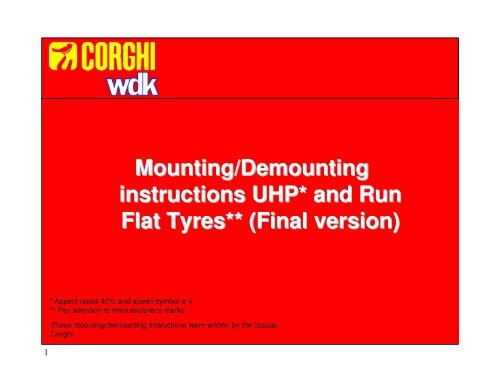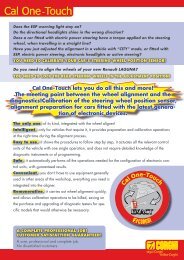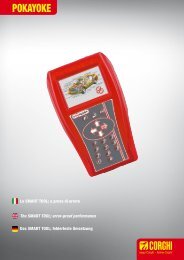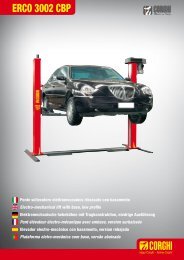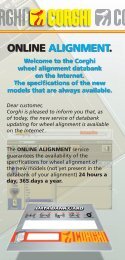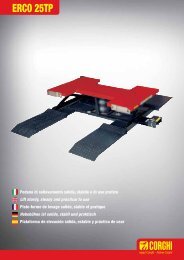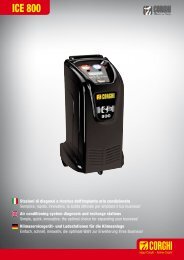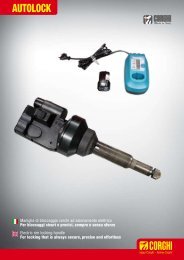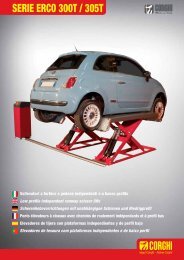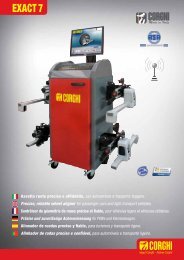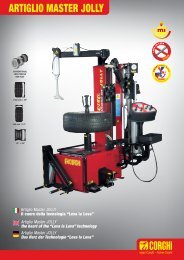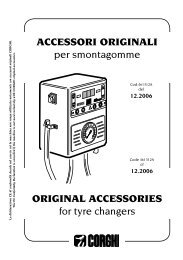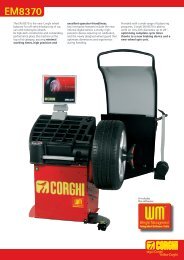Mounting/Demounting instructions UHP* and Run Flat Tyres - Corghi
Mounting/Demounting instructions UHP* and Run Flat Tyres - Corghi
Mounting/Demounting instructions UHP* and Run Flat Tyres - Corghi
Create successful ePaper yourself
Turn your PDF publications into a flip-book with our unique Google optimized e-Paper software.
<strong>Mounting</strong>/<strong>Demounting</strong><br />
<strong>instructions</strong> <strong>UHP*</strong> <strong>and</strong> <strong>Run</strong><br />
<strong>Flat</strong> <strong>Tyres</strong>** (Final version)<br />
1<br />
* Aspect ratio≤ 45% <strong>and</strong> speed symbol ≥ V<br />
** Pay attention to manufacturer's marks<br />
These mounting/demounting <strong>instructions</strong> were written by the Scuola<br />
<strong>Corghi</strong>
Introduction<br />
Due to recent trends towards low-profile tyres with wider <strong>and</strong> lower<br />
aspect ratio as well as run-flat tyres mounting <strong>and</strong> demounting have<br />
become more <strong>and</strong> more complex.<br />
The major requirements for a trouble-free use <strong>and</strong> true running of<br />
the tyre are based on proper <strong>and</strong> professional mounting of the tyre<br />
<strong>and</strong> its correct seat on the rim.<br />
To ensure this, general mounting <strong>and</strong> demounting guidelines are<br />
indispensable in addition to suitable machines <strong>and</strong> equipment <strong>and</strong><br />
the professional competence of the staff.<br />
The wdk guidelines for mounting <strong>and</strong> demounting tyres describe<br />
each work step <strong>and</strong> gives additional hints as to special items which<br />
have to be considered.
Introduction<br />
For the wdk mounting/demounting guidelines tyre <strong>and</strong> car<br />
manufacturers, the German Association of Tyre Trade,<br />
manufacturers of tyre changers, testing institutes, <strong>and</strong> service<br />
providers co-operated to concentrate their knowledge <strong>and</strong><br />
experience in this subject <strong>and</strong> make it available to users.<br />
The wdk mounting/demounting guidelines are to be considered as<br />
the basis for future apprenticeship in the automotive industry <strong>and</strong> for<br />
the design of tyre changers.
Preliminary tests:<br />
• Before carrying out any mounting/demounting<br />
operation of UHP or ran-flat tyres, ensure to<br />
have ready the following tools.<br />
Rim clamp<br />
Bead depressor<br />
Old version<br />
Old version<br />
New version<br />
New version
Lever<br />
Old version<br />
New version<br />
Rim protection<br />
Plastic lever
<strong>Mounting</strong>/demounting<br />
<strong>instructions</strong><br />
<strong>Mounting</strong><br />
6
<strong>Mounting</strong><br />
Lower bead<br />
<strong>Mounting</strong> head<br />
1. Apply sufficient lubricant to<br />
both bead areas!<br />
2. Position the sensor on the<br />
mounting head as shown.<br />
3. Move rim slowly in direction of<br />
rotation.<br />
4. Make sure that the distance<br />
between sensor <strong>and</strong> point of<br />
traction is not less than 15 cm.<br />
5.<br />
Rotation<br />
Sensor<br />
Point of traction
<strong>Mounting</strong><br />
Upper bead<br />
1. Position the sensor on the<br />
mounting head as shown<br />
2. Use bead presser to push the bead<br />
below the rim flange<br />
3. Move rim slowly in direction of<br />
rotation.<br />
4. Use bead presser to keep the bead<br />
in the drop centre of the rim<br />
5. The last part of the bead should slip<br />
over the rim flange near the sensor<br />
<strong>Mounting</strong> head<br />
Rotation<br />
Sensor<br />
Bead presser
Contents<br />
Work step<br />
1. Preparation<br />
2. <strong>Mounting</strong> of a lower<br />
bead<br />
3. <strong>Mounting</strong> of an upper<br />
bead<br />
4. Setting of tyre inflation<br />
pressure<br />
Description<br />
a. Working procedure/activity<br />
b. Important points to be<br />
observed<br />
c. Special points when<br />
h<strong>and</strong>ling run-flat tyres<br />
d. Additional<br />
recommendations<br />
e. Checks<br />
f. Comments/pictures
1 - Preparations (1)<br />
Working<br />
procedures/activities<br />
Important<br />
points to be<br />
observed<br />
Special points<br />
when h<strong>and</strong>ling<br />
run-flat tyres<br />
Additional<br />
Recommendations<br />
Checks<br />
Comments/<br />
Pictures<br />
Observe Health <strong>and</strong><br />
Safety at Work<br />
Regulations<br />
e. g. protective<br />
gloves, ear<br />
protections,<br />
safety shoes<br />
<strong>Mounting</strong> kits for<br />
run-flat tyres<br />
imperatively<br />
required<br />
Basic cleaning of<br />
wheel<br />
Tyre/wheel<br />
assembly at least<br />
+15 ° C<br />
Tyre wash<br />
installation wheel<br />
See Annex 1<br />
1 - Check part<br />
identification<br />
(tyres/rims)<br />
EH2/EH2+ rims<br />
Check rim for<br />
burrs, wear or<br />
other damage<br />
(observe<br />
manufacturer's<br />
specifications);<br />
replace if<br />
necessary<br />
Picture 1<br />
2 - Clamp wheel Clamp wheel in<br />
centred <strong>and</strong> level<br />
position<br />
When rims are<br />
centred/clamped<br />
by their inner side<br />
use special safety<br />
means.<br />
Short bead seat in<br />
top position<br />
Use clamp<br />
protection (for alloy<br />
wheels)<br />
Wheel must be<br />
securely seated<br />
Check clamping<br />
means: they<br />
must be clean<br />
<strong>and</strong> not worn<br />
Picture 2
Check tyre / rim ID<br />
Picture 1
Clamp wheel<br />
Securely seat wheel<br />
Picture 2<br />
Use clamp protection
1 - Preparations (2)<br />
Working<br />
procedures/activities<br />
Important points<br />
to be observed<br />
Special<br />
points when<br />
h<strong>and</strong>ling<br />
run-flat<br />
tyres<br />
Additional<br />
Recommendations<br />
Checks<br />
3 - Valve/seal Replace rubber valve Use suitable tool Clean sealing<br />
surfaces<br />
Visual inspection:<br />
a) Check metal valve<br />
replace if necessary,<br />
b) Sensor:<br />
according to with<br />
manufacturer's specs<br />
Make sure to observe<br />
tightening torques<br />
(metal valve, sensor)<br />
as specified by<br />
manufacturer<br />
Check sensors for<br />
mechanical damage<br />
(if the sensor is<br />
sprinkled with tyre<br />
seal, do not wipe off,<br />
but replace it!)<br />
Use suitable tool<br />
Check for<br />
correct position<br />
<strong>and</strong> tight fitting<br />
Comments/<br />
Pictures<br />
Valve stemming<br />
tool <strong>and</strong> lubrication<br />
Picture 3<br />
Use torque wrench
Replace rubber valve<br />
Picture 3
1 - Preparations (3)<br />
Working<br />
procedures/activities<br />
Important<br />
points to be<br />
observed<br />
Special points<br />
when h<strong>and</strong>ling<br />
run-flat tyres<br />
Additional<br />
Recommendations<br />
Checks<br />
Comments/<br />
Pictures<br />
4 - Lubricate rim no lubricant on<br />
the sensor<br />
Make sure not<br />
to spill lubricant<br />
Lubricate the<br />
complete rim<br />
base,<br />
make sure to use<br />
suitable lubricant<br />
only!<br />
Picture 4<br />
5 - Lubricate tyre Entire bead<br />
outside area<br />
<strong>and</strong> tyre<br />
sidewall up to<br />
upper<br />
decorative line<br />
Approx. 30 mm<br />
in upper bead<br />
inside area<br />
Make sure not<br />
to spill lubricant<br />
Apply uniformly<br />
Visual inspection<br />
Picture 5
Lubricate rim<br />
Picture 4
Lubricate tyre<br />
Entire bead outside area<br />
<strong>and</strong> tyre sidewall up to upper decorative line.<br />
Inside of the upper bead<br />
Picture 5
2 - <strong>Mounting</strong> of lower bead<br />
Working<br />
procedures/activities<br />
Important<br />
points to be<br />
observed<br />
Special points<br />
when h<strong>and</strong>ling<br />
run-flat tyres<br />
Additional<br />
Recommendations<br />
Checks<br />
Comments/<br />
Pictures<br />
6 - Put tyre in place Set mounting<br />
head according<br />
to with<br />
manufacturer's<br />
specifications<br />
Position mounting<br />
head<br />
Position bead<br />
relative to<br />
mounting head<br />
according to<br />
manufacturer's<br />
specifications<br />
Slightly lubricate<br />
mounting head<br />
Check mounting<br />
head for wear<br />
Start mounting<br />
procedure<br />
Position sensor<br />
<strong>and</strong> valve<br />
(approx. 10-15<br />
cm) before point<br />
of traction<br />
Sensor must not<br />
be under load<br />
Avoid excessive<br />
tension of bead<br />
Risk of damaging<br />
the sensor!<br />
Picture 6<br />
Press bead over rim<br />
flange<br />
Check that tyre<br />
is correctly<br />
positioned<br />
relative to<br />
mounting head<br />
Let the mounting<br />
tool turn slowly;<br />
Rim must not slip;<br />
otherwise repeat<br />
procedure<br />
Guide the tyre in the<br />
pulling direction <strong>and</strong><br />
push to drop centre<br />
of rim<br />
Picture 7
Start mounting procedure<br />
Picture 6
Press bead over rim flange<br />
Picture 7
3 - <strong>Mounting</strong> of upper bead (1)<br />
Working<br />
procedures/activities<br />
Important points<br />
to be observed<br />
Special points<br />
when h<strong>and</strong>ling<br />
run-flat tyres<br />
Additional<br />
Recommendations<br />
Checks<br />
Comments/<br />
Pictures<br />
7 - Position upper<br />
bead<br />
Position bead<br />
relative to<br />
mounting head<br />
according to<br />
manufacturer's<br />
specifications<br />
Slightly lubricate<br />
mounting head<br />
Picture 8<br />
Position clamp<br />
Position sensor<br />
<strong>and</strong> valve<br />
(approx. 10-15<br />
cm) before point<br />
of traction<br />
Sensor must not<br />
be under load<br />
Position the fixable<br />
tight clamp<br />
Picture 9<br />
Lubricate bead<br />
presser <strong>and</strong> insert<br />
Use rim<br />
protections for<br />
steel rims to<br />
avoid damage to<br />
bead <strong>and</strong> for<br />
alloy rims to<br />
avoid damage to<br />
both bead <strong>and</strong><br />
rim<br />
Picture 10
Position upper bead<br />
Picture 8
Position clamp<br />
Picture 9
Position clamp <strong>and</strong> bead presser<br />
Use clamp protection<br />
(with aluminium <strong>and</strong><br />
steel wheels)<br />
Picture 10
3 - <strong>Mounting</strong> of upper bead (2)<br />
Working<br />
procedures/activities<br />
Important points<br />
to be observed<br />
Special points<br />
when h<strong>and</strong>ling<br />
run-flat tyres<br />
Additional<br />
Recommendations<br />
Checks<br />
Comments/<br />
Pictures<br />
Mount bead over rim<br />
flange<br />
Mount step by<br />
step, having short<br />
breaks, relieve<br />
tension<br />
Use additional<br />
bead presser<br />
Avoid excessive<br />
deformation at point<br />
of traction<br />
Do not use the<br />
tyre tool as a bead<br />
presser!<br />
Picture 11<br />
If necessary, guide<br />
tyre by h<strong>and</strong><br />
Pay attention to<br />
tension <strong>and</strong> make<br />
sure bead is<br />
correctly seated in<br />
drop centre of rim<br />
During mounting<br />
operation listen for<br />
crackling noise.<br />
Bead base<br />
must be in<br />
contact with<br />
drop centre of<br />
rim<br />
Avoid additional<br />
noise to make<br />
sure you hear<br />
crackling noise<br />
Do not compress<br />
belt edge or<br />
sidewalls with the<br />
bead presser<br />
If possible,<br />
unclamp/remove<br />
bead clamp/bead<br />
presser<br />
Picture 12<br />
Remove all mounting<br />
tools<br />
If needed, use bead<br />
breaking roll as an<br />
aid<br />
Picture 13<br />
Release the wheel<br />
when outer side of<br />
the rim is clamped<br />
<strong>and</strong> remove it from<br />
the tool before<br />
inflating<br />
Make sure clamps<br />
are not caught in<br />
between tyre<br />
sidewall <strong>and</strong> rim<br />
Wheel might be<br />
difficult to remove
Mount step by step<br />
Picture 11
Relieve tension<br />
Picture 12
IMPORTANT:<br />
Do not compress belt edge with<br />
bead presser<br />
Picture 13
3a – <strong>Mounting</strong> of upper bead<br />
with ARTIGLIO MASTER (1)<br />
1. Before beginning mounting operations grease the mounting tool, in the bead of the tyre <strong>and</strong> the<br />
surface of the rim clamp which will come into contact with the tyre. Lubrication of the rim should be<br />
carried out as described by the WDK procedure in the previous mounting phases.<br />
2. Begin the mounting operations of the upper bead, bearing in mind that no excessive stress should<br />
reach the bead. With regard to this, it is recommended to proceed with gradual rotations, making brief<br />
pauses in order to remove tension from the bead.<br />
3. Position the mounting tool in such a way so that the visible indicator (red sign) which is at half the<br />
height of the plastic yellow guard, is in correspondence with the upper margin of the edge of the rim.<br />
The valve should be positioned upstream of the mounting tool in order to avoid any accidental tension<br />
during the mounting operations. Position the bead breaker in such a way that the bead is correctly<br />
directed inside the drop centre. Then proceed with slight rotations.
3a – <strong>Mounting</strong> of upper bead<br />
with ARTIGLIO MASTER (2)<br />
4. With the help of the upper bead breaker or<br />
the pneumatic presser create the necessary<br />
space to insert the rim clamp. Block the rim<br />
clamp <strong>and</strong> the plastic guard on the rim in<br />
such a way that is positioned before the<br />
valve <strong>and</strong> at the point of traction (see arrow).<br />
Correct the position of the bead breaker as<br />
the rim is rotated all the way up to a height<br />
which does not exceed that of the HUMP in<br />
order to be able to correctly direct the bead<br />
breaker in the drop centre..<br />
5. In order to aid mounting of the bead into the drop centre, insert the special pneumatic<br />
presser between the rim clamp <strong>and</strong> the bead breaker, inserted near the rear of the rim<br />
clamp so that the tyre is unstuck from the rim’s protective edge. The bead presser plier<br />
comes with the machine. This does not need any lubrication. Proceed cautiously with<br />
small, clockwise rotations of the rim.
3a – <strong>Mounting</strong> of upper bead<br />
with ARTIGLIO MASTER (3)<br />
6. In order to further reduce the tension on the bead <strong>and</strong> to favour mounting of the tyres with<br />
height/width ratio < 35%, suspend rotation of the rim when the point of traction is on the opposite<br />
side of the mounting tool (rim clamp at 5 o’clock) <strong>and</strong> lower the mounting tool until the plastic<br />
yellow guard on the mounting head is no longer visible below the upper margin of the rim edge.
3a – <strong>Mounting</strong> of upper bead<br />
with ARTIGLIO MASTER (4)<br />
7. Carefully begin rotation of the rim again <strong>and</strong> proceed slowly with mounting of the bead. During this<br />
operation it may be necessary to vary the pressure of the bead breaker on the side of the tyre in<br />
order to direct the bead into the drop centre. The same is true for the pneumatic presser.<br />
8. When mounting is complete extract the tool from the tyre, with the help of the bead breaker<br />
unblock the rim clamp <strong>and</strong> the guard from the edge of the rim <strong>and</strong> disengage the pneumatic<br />
presser from the side of the cover. Proceed with inflation of the tyre.
4 - Setting of inflation pressure<br />
Working<br />
procedures/activities<br />
Important points<br />
to be observed<br />
Special points<br />
when h<strong>and</strong>ling<br />
run-flat tyres<br />
Additional<br />
Recommendations<br />
Checks<br />
Comments/<br />
Pictures<br />
8 - Inflate without valve<br />
stem<br />
Inflate intermittently.<br />
Pay attention to the<br />
BGI 884<br />
requirements of the<br />
German Government<br />
Safety Organisation.<br />
Observe safety<br />
<strong>instructions</strong>. Initial<br />
pressure not to<br />
exceed 3.3 bar!<br />
If tyre does not<br />
respond at 3.3 bars,<br />
deflate again,<br />
lubricate <strong>and</strong> inflate<br />
again.<br />
Picture 14<br />
Max. 4 bar setting<br />
pressure<br />
Check bead seat<br />
(centring line in<br />
parallel to rim<br />
flange)<br />
Picture 15<br />
Screw in valve stem<br />
Use valve stem<br />
according to sensor<br />
manufacturer's<br />
<strong>instructions</strong><br />
Use valve stemming<br />
tool with torque limiter<br />
Set service pressure.<br />
Screw on valve cap.<br />
Wipe off excessive<br />
lubricant
Bar initial pressure<br />
Picture 14
Bar setting pressure<br />
Picture 15
Recommendation<br />
• Test the correct functioning of the<br />
sensor with the appropriate instrument
<strong>Mounting</strong>/<strong>Demounting</strong><br />
<strong>instructions</strong><br />
<strong>Demounting</strong><br />
37
<strong>Demounting</strong><br />
Upper bead<br />
1. Deflate tyre, remove valve stem<br />
2. Break bead preferably using the bead<br />
breaker roll - if using a bead breaker<br />
blade insert it 3 to 4 times at a<br />
distance of 1 cm from the rim flange<br />
• Start at 90°or 270°<br />
• not at 0°or 180°!<br />
3. Position mounting head as shown in<br />
front of valve in direction of rotation<br />
4. Position bead presser at 0°to keep<br />
the tyre in the drop centre of the rim<br />
5. Lift bead over the rim flange using a<br />
coated tyre lever to prevent damage<br />
by the lever<br />
6. Move rim slowly in direction of<br />
rotation<br />
Valve<br />
180°<br />
Rotation<br />
<strong>Mounting</strong> head<br />
Lever<br />
90° 270°<br />
0°
<strong>Demounting</strong><br />
Lower bead<br />
1. Position mounting head as shown<br />
in front of sensor in direction of<br />
rotation<br />
2. Lift bead over the rim flange using<br />
the tyre lever<br />
3. Move rim slowly in direction of<br />
rotation.<br />
Sensor<br />
Rotation<br />
<strong>Mounting</strong> head<br />
Lever (when<br />
available)
Contents<br />
Work step<br />
1. Preparation<br />
2. Roller TC<br />
• Clamp wheel<br />
• Break bead<br />
3. Bead breaker<br />
• Break bead<br />
• Clamp wheel<br />
4. Position wheel<br />
5. Lift upper bear over rim<br />
flange<br />
6. Demount upper bead<br />
7. Lift lower bead over rim<br />
flange<br />
Description<br />
a. Working<br />
procedures/activities<br />
b. Important points to be<br />
observed<br />
c. Special points when<br />
h<strong>and</strong>ling run-flat tyres<br />
d. Additional recommendations<br />
e. Checks<br />
f. Comments/pictures
1 - Preparations (1)<br />
Working<br />
procedures/activities<br />
Important points<br />
to be observed<br />
Special points<br />
when h<strong>and</strong>ling<br />
run-flat tyres<br />
Additional<br />
Recommendations<br />
Checks<br />
Comments/<br />
Pictures<br />
Observe Health <strong>and</strong><br />
Safety at Work<br />
Regulations<br />
e. g. protective<br />
gloves, ear<br />
protections,<br />
safety shoes<br />
Basic cleaning of<br />
wheel<br />
Wheel wash<br />
installation<br />
1 - Determine<br />
wheel/tyre type<br />
St<strong>and</strong>ard or runflat<br />
tyres.<br />
Tyre temperature<br />
at least 15°C<br />
(see Annex 1)<br />
Rim type<br />
(EH2/EH2 + ), tyre<br />
manufacturer's<br />
code, e.g. "RF" or<br />
snail symbol<br />
TPMS type (directly<br />
measuring sensor/<br />
no sensor);<br />
Damaged tyres<br />
must not be used<br />
again<br />
Please refer to the<br />
WDK –Annex<br />
"Criteria<br />
catalogue"<br />
(www.wdk.de)<br />
2 - Unscrew valve<br />
stem, deflate<br />
Use suitable tool<br />
to unscrew valve<br />
stem<br />
Proceed only when<br />
tyre is completely<br />
deflated<br />
3 - Remove old<br />
balancing weights<br />
Use suitable tool<br />
Avoid damage to<br />
rim
Roller TC<br />
Working<br />
procedures/activities<br />
Important points<br />
to be observed<br />
Special points<br />
when h<strong>and</strong>ling<br />
run-flat tyres<br />
Additional<br />
Recommendations<br />
Checks<br />
Comments/<br />
Pictures<br />
4 - Clamp wheel Clamp wheel in<br />
centred <strong>and</strong> level<br />
position<br />
Use fuses when<br />
rims are clamped<br />
by the inner side.<br />
Short bead seat on<br />
top position<br />
Use clamp<br />
protection (for alloy<br />
rims)<br />
Check clamping<br />
means: they must<br />
be clean <strong>and</strong> not<br />
worn<br />
Wheel must be<br />
securely seated<br />
Picture 16<br />
5 - Break upper<br />
bead using bead<br />
breaker roll<br />
Pay attention to<br />
position of<br />
sensor, do not<br />
apply bead<br />
breaking in this<br />
area<br />
Only until bead<br />
slips over hump<br />
Maintain a safe<br />
distance from sensor<br />
Check whether tyre<br />
was pressed over<br />
hump over its<br />
complete<br />
circumference<br />
Picture 17<br />
Apply suitable<br />
lubricant as<br />
deeply as<br />
possible between<br />
rim <strong>and</strong> tyre,<br />
apply roll directly<br />
above rim flange<br />
Apply bead<br />
breaker roll on<br />
bead only, never<br />
on tyre sidewall<br />
After bead breaking<br />
procedure check<br />
correct clamping<br />
position Picture 18
Clamp wheel<br />
Picture 16
Break upper bead using bead breaking roll<br />
Picture 17
Use sufficient lubricant<br />
Picture 18
Bead breaker (1)<br />
Working<br />
procedures/activities<br />
Important<br />
points to be<br />
observed<br />
Special points<br />
when h<strong>and</strong>ling<br />
run-flat tyres<br />
Additional<br />
Recommendations<br />
Checks<br />
Comments/<br />
Pictures<br />
4.1 - Break bead<br />
onside of short<br />
bead seat<br />
Pay attention to<br />
position of<br />
sensor.<br />
Make sure to<br />
use stroke<br />
limiter of bead<br />
breaking shoe<br />
Apply bead<br />
breaker shoe on<br />
bead only. never<br />
on tyre sidewall<br />
Maintain a safe<br />
distance from<br />
sensor<br />
Check<br />
whether tyre<br />
was pressed<br />
over hump on<br />
its complete<br />
circumference<br />
Picture 19<br />
Apply bead<br />
breaker shoe<br />
as closely as<br />
possible to rim<br />
flange without<br />
damaging the<br />
rim (use plastic<br />
protection)<br />
Avoid damage by<br />
bead breaker<br />
shoe to hump<br />
EH2/EH2+- rims<br />
(use plastic<br />
protection)
Break bead<br />
•Stroke limiter<br />
Bead breaking shoe with stroke limiter<br />
Picture 19
Bead breaker (2)<br />
Working<br />
procedures/activities<br />
Important<br />
points to be<br />
observed<br />
Special points<br />
when h<strong>and</strong>ling<br />
run-flat tyres<br />
Additional<br />
Recommendations<br />
Checks<br />
Comments/<br />
Pictures<br />
4.2- Break bead on<br />
side of long bead seat<br />
Pay attention to<br />
Working procedures/activities<br />
position of shoe Important on bead only,<br />
points to be observed sensor. Special never points on tyre when<br />
sidewall<br />
h<strong>and</strong>ling run-flat tyres Additional<br />
Make sure to use<br />
recommendations Checks Comments/<br />
Pictures<br />
stroke limiter of<br />
bead breaker<br />
shoe<br />
Apply bead breaker<br />
Maintain a safe<br />
distance from sensor<br />
Check whether<br />
tyre was pressed<br />
over hump on its<br />
complete<br />
circumference<br />
Apply bead<br />
breaker shoe as<br />
closely as<br />
possible to rim<br />
flange without<br />
damaging the rim<br />
(use plastic<br />
protection)<br />
Avoid damage by<br />
bead breaker shoe<br />
to hump EH2/EH2+rims<br />
(use plastic<br />
protection)<br />
5 - Place wheel on tyre<br />
changer <strong>and</strong> secure it<br />
Use clamping<br />
means<br />
Use clamping aid<br />
Use clamp protection<br />
Use auxiliary<br />
means so as not<br />
to catch the tyre<br />
during the<br />
clamping<br />
operation<br />
Picture 20
Place wheel on tyre changer<br />
Use clamp protection<br />
Picture 20
All tyre changers (1)<br />
Working<br />
procedures/activities<br />
Important points to be<br />
observed<br />
Special points<br />
when h<strong>and</strong>ling<br />
run-flat tyres<br />
Additional<br />
Recommendations<br />
Checks<br />
Comments/<br />
Pictures<br />
6 - Rotate wheel<br />
into demounting<br />
position<br />
Sensor/Valve should sit<br />
under the head next to the<br />
mounting lever/mounting<br />
finger<br />
Avoid compression of belt<br />
edge<br />
Use suitable runflat<br />
lever l (for<br />
instance with<br />
plastic protection)<br />
Use suitable bead<br />
presser - opposite to<br />
the mounting head -<br />
to retain the tyre in<br />
the drop-centre of<br />
the rim<br />
Picture 21<br />
Use rim protection for steel<br />
wheels to avoid bead damage<br />
Apply lubricant on<br />
both sides of the<br />
demounting tool<br />
Position mounting<br />
head<br />
When levering the bead<br />
over the rim flange make<br />
sure that the demounting<br />
tool does not collide with<br />
sensor <strong>and</strong> the inner liner<br />
is not damaged<br />
Apply utmost care<br />
when using lever<br />
without stop (do not<br />
insert too deeply)<br />
Position of<br />
sensor <strong>and</strong><br />
of<br />
rim<br />
protection<br />
Picture 22<br />
7 - Lift upper tyre<br />
bead over rim flange<br />
Carry out steps slowly <strong>and</strong><br />
carefully.<br />
Do not overstretch tyre<br />
bead, use auxiliary tools to<br />
relieve tension from upper<br />
bead<br />
This needs to be<br />
removed when<br />
using lever without<br />
plastic protection
Wheel in demounting position<br />
Valve<br />
180°<br />
<strong>Mounting</strong> head<br />
Sensor<br />
<strong>Mounting</strong> head<br />
Lever (when available)<br />
Lever (when<br />
available)<br />
90° 270°<br />
Rotation<br />
Rotation<br />
0°<br />
Picture 21
Wheel in demounting position<br />
Picture 22
All tyre changers (2)<br />
Working<br />
procedures/activities<br />
Important points<br />
to be observed<br />
Special points<br />
when h<strong>and</strong>ling<br />
run-flat tyres<br />
Additional<br />
Recommendations<br />
Checks<br />
Comments/<br />
Pictures<br />
7 - Lift upper tyre<br />
bead over rim flange<br />
Carry out steps<br />
slowly <strong>and</strong><br />
carefully.<br />
Do not overstretch<br />
tyre bead, use<br />
auxiliary means to<br />
relieve tension from<br />
upper bead<br />
8 - Demount upper<br />
bead<br />
Let the mounting<br />
tool turn slowly<br />
<strong>and</strong>, during the<br />
rotation operation,<br />
relieve tension from<br />
the bead presser<br />
<strong>and</strong> from the roller<br />
Ensure sufficient<br />
lubrication between<br />
bead <strong>and</strong> rim flange<br />
Avoid relative<br />
movement between<br />
tyre <strong>and</strong> rim, guide<br />
the tyre<br />
10 - Rotate wheel<br />
into position for<br />
demounting<br />
Sensor/Valve<br />
should sit under the<br />
head next to the<br />
mounting<br />
lever/mounting<br />
finger<br />
Ensure sufficient<br />
lubrication between<br />
bead base <strong>and</strong> rim<br />
flange<br />
If necessary, reapply<br />
lubricant
Lift upper tyre bead over rim flange<br />
With the A50: in case the tyre bead does not slip over the tyre,<br />
use the plastic lever<br />
Picture 23<br />
With the A50 – push from below<br />
in order to relieve the tension
All tyre changers (3)<br />
Working<br />
procedures/activities<br />
Important<br />
points to be<br />
observed<br />
Special points<br />
when h<strong>and</strong>ling runflat<br />
tyres<br />
Additional<br />
Recommendations<br />
Checks<br />
Comments/<br />
Pictures<br />
9 - After demounting<br />
the upper bead,<br />
remove lever<br />
Do not damage<br />
the rim <strong>and</strong> the<br />
sensor<br />
10 - Rotate wheel<br />
into position for<br />
demounting<br />
Sensor/Valve<br />
should sit under<br />
the head next to<br />
the mounting<br />
lever/mounting<br />
finger<br />
Ensure sufficient<br />
lubrication between<br />
bead base <strong>and</strong> rim<br />
flange<br />
If necessary,<br />
reapply lubricant<br />
Picture 25<br />
Position the<br />
demounting tool<br />
If necessary,<br />
remove auxiliary<br />
equipment<br />
11 – Lift lower tyre<br />
bead over rim<br />
flange<br />
Carry out steps<br />
slowly <strong>and</strong><br />
carefully<br />
Tyre bead must be<br />
fully retained in the<br />
drop centre of the<br />
rim opposite to the<br />
mounting head<br />
Position<br />
Sensor
Wheel in demounting position<br />
With the A50: in case the tyre bead does not slip over the tyre,<br />
use the plastic lever<br />
Picture 25
Lift lower tyre bead over rim flange<br />
Picture 26
All tyre changers<br />
Working<br />
procedures/activities<br />
Important<br />
points to be<br />
observed<br />
Special points<br />
when h<strong>and</strong>ling<br />
run-flat tyres<br />
Additional<br />
Recommendations<br />
Checks<br />
Comments/<br />
Pictures<br />
12 - Lift tyre from rim Do not<br />
damage rim<br />
Remove additional<br />
means<br />
13 - Check sensor<br />
for damages <strong>and</strong>, if<br />
necessary, replace it<br />
Picture 27<br />
14 - Clean tyre<br />
beads <strong>and</strong> check for<br />
any damage<br />
15 - Check rim for<br />
burrs, wear or other<br />
damage (observe<br />
manufacturer's<br />
specifications);<br />
replace if necessary<br />
Check bead<br />
inner <strong>and</strong><br />
outer sides
TMPS Reader<br />
Picture 27
<strong>Mounting</strong>/<strong>Demounting</strong><br />
Instructions<br />
<strong>UHP*</strong> <strong>and</strong> <strong>Run</strong>-<strong>Flat</strong> <strong>Tyres</strong>**<br />
System 1<br />
<strong>Tyres</strong> warming-up<br />
* Aspect ratio ≤ 45 % <strong>and</strong> speed symbol ≥ V<br />
** Pay attention to manufacturer's marks<br />
60
It is recommended to warm up cold tyres to at<br />
least mounting temperature of + 15 °C<br />
For the mounting of run-flat tyres, it is necessary that the tyre's upper<br />
sidewalls <strong>and</strong> the upper beads are warmed on the inside at at least 15 °C.<br />
This inner temperature is called core temperature.<br />
Rubber is a bad heat conductor, <strong>and</strong> for this reason, cold tyres should be<br />
placed in a warm environment until the inner temperature of the rubber<br />
reaches min. 15 °C .<br />
The surface temperature of the tyres during the warming-up phase is not an<br />
indication of the inner temperature!<br />
The room temperature is typically measured <strong>and</strong> read at eye level. At 19 °C<br />
eye-level temperature the ground temperature is of circa 16 °C. This means<br />
that cold tyres should not be left in direct contact with the ground, but at least<br />
on an insulating cover, on a pallet, or ever more distant from the ground.
It is recommended to warm up cold tyres to<br />
at least mounting temperature of + 15 °C<br />
<strong>Tyres</strong> should not be piled up, but rather stored individually so that they could<br />
"absorb" as quickly as possible the temperature from the warm environment.<br />
In no case, tyres should be warmed up by means of infra-red heaters or hotair<br />
blowers heating devices , as the surface damaging temperature can be<br />
quickly reached. Except from warm water or warm ventilation (max. 50°C, not<br />
warmer!), there is no other way to warm up the tyre without damaging it.<br />
If cold tyres are taken (under 0 °C) to a warm environment (over 0 °C), on the<br />
tyre's surface a frost film will immediately form. This frost film shows that the<br />
tyres have absorbed intensively heat through condensation of the humidity<br />
from the surrounding environment. If the frost film melts <strong>and</strong> condensation is<br />
formed, this should be wiped off with a dry cloth to avoid that the subsequent<br />
warming process is compromised by evaporating heat loss.
Summary<br />
Environments with at least 19 °C room temperature:<br />
• <strong>Tyres</strong> with initial temperature of 0 °C <strong>and</strong> higher: store for min. 2 h ,<br />
• <strong>Tyres</strong> with starting temperature below 0 °C: store for min. 2 1/2 h .<br />
Recommendations for warming-up:<br />
– On insulated covers, pallets, or similar . - if possible store high up<br />
with the „upper“ beads facing up<br />
– Position the tyres individually, so that they could "absorb"<br />
the warm air<br />
– Wipe off condensation water<br />
– do not blow/spray with heating devices!


